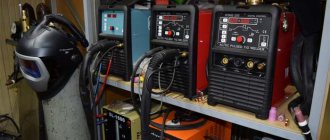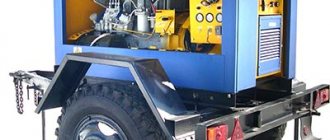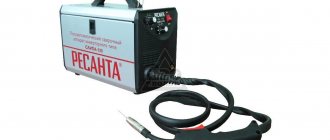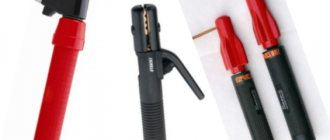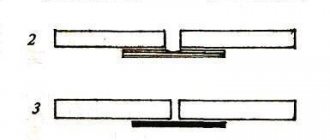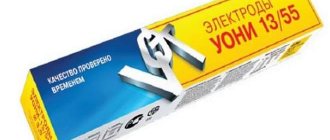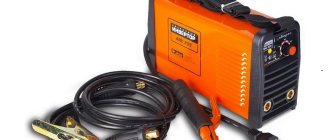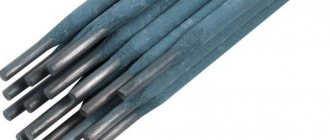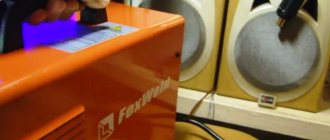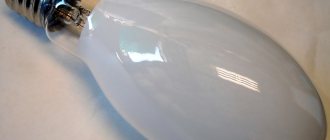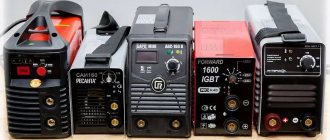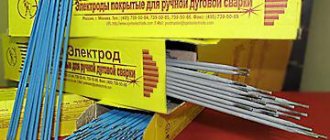Scope of application
The high pressure welding machine is used as a current source to ignite and maintain the arc for the process of welding, surfacing and gouging of steel. It is used when laying pipelines and steel structures:
- low carbon;
- structural;
- corrosion resistant.
The bath is protected by hydrocarbon . On units of the VD-306 series, welding is performed with electrodes of various brands, including non-consumable ones under argon.
Precautionary measures
Welder protective equipment
Before operating the VD 306, you should carefully study the state standards for welding work and the use of electrical installations. This device is strictly prohibited from being used inside tunnels, wells, or metal tanks. Do not use the device without the protective casing. If the welding unit is connected to an electrical network, then it is prohibited to move it.
During operation, a person must not touch the metal elements of the unit and the electrodes. The welder should be unplugged before removing or installing the welding rod.
Cleaning the seams should be done after the metal has completely cooled. This work must be performed with special glasses. The welding itself must be carried out using a special mask, which protects the welder’s face from molten metal particles.
Video on the topic: Repair of welding machine VD 306
Publications on the topic
How to independently repair inverter-type welding machines
The procedure for making a semi-automatic welding machine with your own hands
The process of making a spotter with your own hands from a welding machine
Specifications
The unit is designed for welding in MMA and TIG modes. The welding transformer VD 306 has the following technical characteristics and positive qualities:
- works from 3 phase current and generator;
- smooth adjustment of settings;
- operation in the temperature range from – 40⁰ to + 60⁰;
- not sensitive to voltage surges and decreases;
- the level of stabilization is high;
- easy ignition.
Most models in this series have an operating mode of 60%. They work equally well at equipped posts and in field conditions far from power lines.
Malfunctions and their solutions
The rectifier is equipped with high voltage windings, which are considered the weak point of any welding equipment. If used incorrectly, they burn out completely or partially. In such cases, replacement or rewinding is required. Malfunctions also affect the control board.
The following components are especially likely to fail:
- rectifier bridge diodes;
- paths;
- control unit transformers.
First of all, check the diode bridge. The component is quite reliable, but if used incorrectly, it fails. If the tracks burn out, the board will have to be replaced; repair in this case is impossible. This method is not considered the best solution; new electronic components are expensive.
We recommend reading Types of welding machines
Therefore, they try to restore the existing block:
- use a universal tester to call device components, the failure of which could render the device inoperable;
- replace failed parts;
- they launch the device and test it.
Design features and operating principle
The rectifier VD-360 is relatively small in weight and dimensions. For ease of movement, many models have wheels. Built-in grounding. A three-phase step-down transformer provides a falling external characteristic .
Unstable voltage does not affect the output current. The rectifier consists of units and parts:
- frame;
- control Panel;
- winding;
- rectifier;
- stabilizer;
- circuit breakers;
- fan.
The cooling system is forced, the fan turns on automatically along with the equipment. On the body of the device there are:
- push-button switch;
- control panel with digital display and adjustment knobs;
- ammeter;
- network connector;
- welding cable connectors;
- warning lamp;
- ground bolt.
Rotating handles allow you to smoothly adjust the current strength and other parameters. In case of overheating, the rectifier automatically switches off.
Contents of delivery
The VD series welding rectifier is supplied complete with:
- current converter;
- passport;
- power cable.
The new device is packaged in cardboard boxes. They indicate the model and technical characteristics of the rectifier. Additionally, holders for coated and non-consumable electrodes may be included .
Varieties
Welders of the VD-306 series are presented in modifications: ST, B, Sh, M1 and special versions for a specific climate, for example UZ.
Comparative characteristics of the welding machine VD 306 in various design changes.
| Options | VD-306B | VD-306M UZ | VD-306 UZ |
| Dimensions, mm | 690×360×640 | 1 040×360×315 | 660×565×510 |
| Weight, kg | 87 | 65 | 104 |
| Rated current, A | 300 | 315 | 315 |
| Operating mode, % | 25 | 55 | 65 |
| Current regulation limits, A | from 25 | from 30 | from 30 |
| No-load current, A | 70 | 75 | 80 |
All rectifiers listed in the table have the same indicators:
- 3 phases;
- industrial voltage 380 V;
- working – 32 V;
- smooth adjustment.
The digital display and stepless control allow you to precisely adjust the equipment to the required mode.
Unacceptable operating conditions
Considering the design of the device, the welding transformer VD 306 is prohibited from operating in rooms where the atmosphere contains:
- dust;
- vapors of caustic substances;
- fire hazardous atmosphere;
- substances that destroy insulating materials.
Important! Working in conditions harmful to the machine leads to the destruction of the equipment and endangers the health of the welder.
For modifications
Model VD-306 is a mobile all-body welding machine and consists of:
- transformer;
- rectifier;
- magnetic shunt;
- emergency shutdown system;
- fan;
- casing
The VD-306 rectifier feeds the electric arc and operates with a direct current output. Performs surfacing and welding . Connects to industrial current 380V.
Operating parameters of VD-306:
- current 315 A;
- mode 60%;
- voltage from 32 V;
- welding current limits 30 – 315 A;
- the adjustment is smooth.
The rectifier is packaged together with a 3 m cable and a passport in the usual version and with ultrasonic climate protection. Protection degree IP22 . The ground clamp is located on the base of the chassis.
The presence of a welding choke in the design of the rectifier makes it possible to weld high-alloy steels with a non-consumable electrode in an argon environment with or without the use of filler wire.
Setting modes and circuit
Opening and closing the magnetic shunt changes the inductive leakage. The shift is made by rotating the handle on the top of the body. The current value required for operation is set depending on the electrodes used and the type of metal being welded.
Current is supplied to the primary winding, then the inductor forms a saturated electromagnetic field. It creates an excitation current, which stabilizes and passes through the rectifier to the holder, forming an arc.
Another rectification circuit is also used, using diodes or thyristors in continuously variable welding machines
Classification and labeling
All versions of welding rectifiers are divided according to the following parameters:
- According to the phase of the current used: single or three phase. The former are compact, but do not allow smoothing out significant voltage ripples and obtaining significant processing currents at the output, therefore they are used mainly for welding machines for household use.
- According to the method of controlling the strength of the welding current.
- According to the type of current-voltage characteristic.
- According to the current rectification circuit. It can be single-phase (used in low-power devices), three-phase or six-phase (the latter is used in high-power units exceeding 1000 kVA). In turn, three-phase rectification can be implemented using bridge or ring circuits.
- Depending on the number of posts served - single-post or multi-post.
The marking of welding rectifiers is regulated by the requirements of GOST 13821-77 (for single-station units) and GOST 18142-85 (for semiconductor units). It includes the letters VD (arc rectifier), the third letter U (universal), or M - multi-station. This is followed by the value of the welding current in amperes multiplied by 10, and (optionally) the series number. Thus, for example, the universal welding rectifier type VDU-504 is designed to produce direct current up to 500 A.
GOST 13821-77 establishes the following relationships between the energy characteristics of a welding rectifier and the duration of its continuous operation. In particular, in the range of welding currents 400...630 A, the minimum operating voltage cannot be less than 24...25 V, and duty cycle - more than 60%. At currents of 800 A or more, the minimum voltage is 26...34 V, and duty cycle can reach 100%.
The lineup
Marking VD-306 means arc rectifier, 30 A rated current, model version 6. The unit has been operating for several decades in various conditions where other welding machines cannot withstand and quickly break down. Therefore, modernized devices have been created on its basis. The VD-306 series has many modifications . The most popular models among welders:
- VD-306D for large-scale production and work in field conditions;
- rectifier VD-306Sh operates from a network of 380 W and consumer 220 W;
- the improved VD-306M1 allows you to cook additionally with alternating turns;
- VD-306I is an upgraded modern inverter device based on a rectifier.
In addition, there are models made in various climatic versions for work in northern and tropical conditions.
Basic malfunctions and maintenance of welding machines
Before connecting to the network for the first time, new converters must be purged. An ordinary household hair dryer is suitable for these purposes. It is turned on at maximum speed at an average warm-up level. This is done in order to dry any possible accumulation of moisture inside and remove dust that reduces the resistance of the copper winding. Blowing should be repeated approximately once a quarter.
If there was a long break in the operation of the equipment (up to 1 year), then before turning it on you need to “pump” the semiconductors. The essence of the procedure is to let the rectifier operate in different modes, starting with idle. This “break-in” lasts approximately two hours. After this, the welding machine will work flawlessly and stably under different conditions. It is necessary to monitor the condition of the main components and prevent the equipment from overheating.
The most common malfunctions of welding equipment and ways to eliminate them:
- The equipment does not work when connected to the power supply. Possible reasons:
- fracture of the supply wiring strand. In this case, the contacts in the plug “dangle”. The plug needs to be replaced;
- no voltage in the network. You should check the switch at the entrance and make sure it is turned on;
- One of the system nodes has failed. It will be very difficult to repair it yourself without proper training. It is better to take the device to a workshop;
- The semiconductor resource has been exhausted. The circuit needs to be re-soldered.
- The electrodes stick and at this moment the hum of the converter is heard. What you can do:
- check the serviceability of the capacitor and semiconductors;
- measure the performance of the power supply network and make sure that the voltage corresponds to the nominal value;
- make sure the throttle wiring is intact.
- During operation, the inverter switches off unexpectedly. This may happen:
- in case of overheating. You should make sure that the cooling system and fan are in good working order;
- if the integrity of the winding of the built-in transformer is damaged. You need to replace the old one with a new one.
- The voltage is unstable when operating under load or at idle speed. You should check:
- regulator knob;
- fuse installed on the primary winding;
- reliability of starter terminal contacts.
If the welding machine no longer maintains the required operating parameters, overheating may be the likely cause. To verify this, just touch the body. If it is hot, then you need to give the generator a break and check how freely air flows to the fan.
Preparing the device: rules of use
Before starting work, you should inspect the integrity of the housing, insulation of cables and hoses. Check all contacts, terminals, clamps. After this, you should connect the case grounding and turn on the device.
Before starting work, you should set the settings and make a test seam. after that you can start working.
Welder of the 5th category of the central steelworks plant of Large-sized metal structures Bogdanov S.D.: “Dust settles on the windings and microcircuits of the equipment and leads to overheating and disruption of operation. If there is a compressor on site, the rectifier should be blown with a stream of compressed air through the air intake slots before operation. If work is carried out outdoors with normal dustiness, cleaning should be done once a week. Welding in an industrial enterprise with a large number of stations requires daily maintenance of the device. After this, you can begin checking connections and terminals. If there is no compressor, the dust is removed with a soft brush.”
How does a welding rectifier work and on what principle does it function?
The welding rectifier is designed from several blocks, inside of which the incoming voltage is reduced and converted while simultaneously increasing the value of A. The design of the welding rectifier allows you to understand the basic principles of its operation.
The design of the unit consists of the following elements:
- three-phase transformer that reduces the incoming voltage;
- diodes that pass current in one direction, as opposed to conductors of electric current, which can conduct current equally well in both directions;
- radiators and fan for cooling the structure;
- ammeter;
- voltmeter;
- current regulators.
Since the diodes heat up during operation of the unit, they require a high-quality cooling system. For this reason, cooling modules are located next to them, providing the structure with constant flow of cold air.
This eliminates the risk of overheating the diodes, increases the operating time of the rectifier and eliminates the need for interruptions in its operation.
Such units can have different characteristics and are designed for welding workpieces made of steel and non-ferrous alloys. But all types of such equipment operate on the same principle.
Diagram of a rectifier with a transformer with increased dissipation.
The welding rectifier circuit looks like this:
- alternating or mains current is supplied to the primary winding of the step-down transformer, which leads to a decrease in its standard value;
- a voltage flow with a reduced value of V and an increased current A appears on the secondary winding due to electromagnetic induction;
- the voltage is supplied to silicon diode elements, which ensure the passage of current in one direction and its stabilization;
- fluctuations in the frequency of the current are eliminated, after which a constant voltage is supplied to the area where the parts are connected.
Any DC welding machine operates according to a similar scheme, providing the welder with ample opportunities in his work.
After all, rectifiers for welding work allow welding and cutting with a stable arc to produce higher-quality seams on various metal structures by converting the current from the transformer into direct voltage inside the unit.
During operation, consumables do not splash, so significant savings occur.
Important! The voltage during operation of welded rectifiers at idle speed should not exceed a level of 48V
Work safety
The safety requirements state:
- The place for welding must be equipped with a fire shield;
- you cannot turn on the equipment without grounding;
- if the cable is damaged, it should be replaced;
- all contacts must be tightened;
- the part is placed on a special rack or plate and secured.
The welder must work in a special suit made of non-flammable material, leather boots, gloves and a mask. To preserve the equipment, it is imperative to maintain the operating mode and allow the device to cool.
Malfunctions and their solutions
The rectifier is equipped with high voltage windings, which are considered the weak point of any welding equipment. If used incorrectly, they burn out completely or partially. In such cases, replacement or rewinding is required. Malfunctions also affect the control board.
The following components are especially likely to fail:
- rectifier bridge diodes;
- paths;
- control unit transformers.
First of all, check the diode bridge. The component is quite reliable, but if used incorrectly, it fails. If the tracks burn out, the board will have to be replaced; repair in this case is impossible. This method is not considered the best solution; new electronic components are expensive.
Therefore, they try to restore the existing block:
- use a universal tester to call device components, the failure of which could render the device inoperable;
- replace failed parts;
- they launch the device and test it.
Manufacturing companies
In the Russian Federation, several enterprises produce VD-306 rectifiers. Among them:
- LLC "RVS-Techno M" - Moscow;
- LLC "TDAvtomatika" Smolensk;
- JSC NTS St. Petersburg.
In specialized stores you can purchase products from other manufacturers. Rectifiers differ in the design of the housing and some characteristics .
For a long time, VD-306 rectifiers have proven that a simple device can guarantee high-quality welding. The equipment operates reliably in different conditions.
